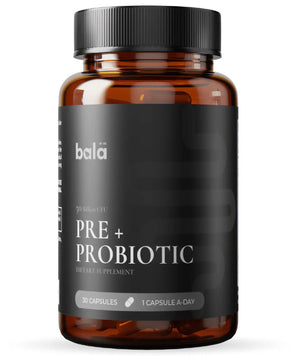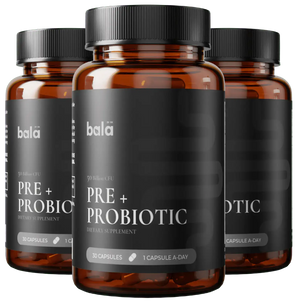Table of Contents
Introduction
Did you know that the human gut is home to trillions of microorganisms, outnumbering our own cells? This complex ecosystem, often referred to as the gut microbiota, plays a critical role in our overall health, influencing everything from digestion to immunity and even mood. With the rising awareness of the gut-brain connection and the importance of gut health, many of us are looking to enhance our well-being through diet.
Are you confused about what food sources are rich in probiotics and prebiotics? You're not alone! Navigating the myriad options available in the health food aisle can be overwhelming, especially with the gimmicks and misinformation that can cloud our choices. At Bala Health, we believe that understanding gut health shouldn’t be complicated. Our mission is to empower you with science-backed information about probiotics and prebiotics so you can make informed decisions about your health.
In this blog post, we will dive deep into the world of probiotics and prebiotics. We will explain what they are, the differences between them, and why they are essential for our gut health. You will also discover various food sources rich in these beneficial compounds, along with practical tips on how to incorporate them into your diet. By the end, you'll be equipped with the knowledge to enhance your gut health and overall wellness.
Let’s embark on this journey to better gut health together!
Understanding Probiotics and Prebiotics
What are Probiotics?
Probiotics are live microorganisms, typically bacteria or yeasts, that confer health benefits to the host when consumed in adequate amounts. They are often referred to as "good" or "friendly" bacteria and are primarily found in fermented foods. Probiotics help balance the gut microbiota, support digestion, and may even play a role in mental health.
What are Prebiotics?
In contrast, prebiotics are types of non-digestible fiber compounds that serve as food for probiotics and other beneficial microorganisms in the gut. They help stimulate the growth and activity of these friendly bacteria, effectively nourishing them. Unlike probiotics, prebiotics are not live organisms but rather the dietary fibers that our gut bacteria thrive on.
The Importance of Both
Both probiotics and prebiotics are essential for maintaining a healthy gut microbiota. While probiotics introduce beneficial bacteria into the system, prebiotics ensure that these bacteria have the nutrients they need to flourish. This symbiotic relationship is crucial for optimizing digestive health, supporting the immune system, and even enhancing mood and cognitive function.
Food Sources Rich in Probiotics
Now that we understand what probiotics are and their significance, let’s explore some of the best food sources where you can find these beneficial microbes.
1. Yogurt
Yogurt is perhaps the most well-known source of probiotics. Made by fermenting milk with specific bacterial cultures, yogurt can be a delicious and versatile addition to your diet. When choosing yogurt, look for varieties labeled “live and active cultures” to ensure they contain beneficial probiotics.
Ways to Include Yogurt:
- Enjoy it with fruits and nuts for breakfast.
- Use it as a base for smoothies.
- Substitute it for mayonnaise in dressings and dips.
2. Kefir
Kefir is a fermented milk drink that contains a larger variety of probiotic strains than yogurt, making it a potent source of beneficial bacteria. It is made by adding kefir grains to milk, resulting in a tangy, effervescent beverage.
Benefits of Kefir:
- Rich in calcium and vitamin B12.
- Easier to digest for those with lactose intolerance.
3. Sauerkraut
Sauerkraut is finely shredded cabbage that has been fermented by lactic acid bacteria. It is not only a probiotic powerhouse but also rich in vitamins C and K.
Tip: Always choose unpasteurized sauerkraut, as pasteurization kills the beneficial bacteria.
4. Kimchi
Kimchi is a spicy Korean dish made from fermented vegetables, primarily napa cabbage and radishes. It is packed with flavor and probiotics, making it an excellent addition to various meals.
Ideas for Using Kimchi:
- Add it to rice bowls or tacos for a spicy kick.
- Use it as a topping for sandwiches and salads.
5. Miso
Miso is a traditional Japanese seasoning made from fermented soybeans, barley, or rice. It is commonly used in soups and dressings and provides a rich source of probiotics along with important nutrients.
6. Tempeh
Tempeh is another fermented soybean product, originating from Indonesia. It has a firm texture and nutty flavor, making it an excellent plant-based protein source. The fermentation process enhances its nutritional profile, making minerals more bioavailable.
7. Kombucha
Kombucha is a fermented tea beverage known for its tangy taste and effervescence. It contains a variety of probiotic strains, making it a refreshing option for gut health.
8. Pickles
While not all pickles contain probiotics, those that are naturally fermented in brine (saltwater) do. Look for pickles that state “live cultures” on the label to ensure they contain beneficial bacteria.
9. Aged Cheese
Certain types of aged cheese, such as gouda, cheddar, and swiss, can be sources of probiotics. As with other fermented foods, look for those that specify “live cultures.”
10. Traditional Buttermilk
Traditional buttermilk is the liquid left after churning butter and contains beneficial probiotics. However, be cautious as many commercial buttermilk products do not retain these probiotics.
Summary of Probiotic Foods
- Yogurt
- Kefir
- Sauerkraut
- Kimchi
- Miso
- Tempeh
- Kombucha
- Pickles
- Aged Cheese
- Traditional Buttermilk
Incorporating these foods into your diet can help enhance your gut health, paving the way for improved overall wellness.
Food Sources Rich in Prebiotics
Now that we’ve covered probiotics, let’s explore the world of prebiotics.
1. Garlic
Garlic is not only a flavorful addition to many dishes but also a rich source of prebiotics. It contains inulin and other fructooligosaccharides that promote the growth of beneficial bacteria in the gut.
2. Onions
Onions are another excellent source of prebiotics, particularly inulin. They can be used in a variety of dishes, from salads to soups, adding both flavor and health benefits.
3. Asparagus
Asparagus is a delicious vegetable that provides a good amount of prebiotic fiber. Roasting or grilling asparagus can enhance its flavor while preserving its health benefits.
4. Bananas
Bananas, especially when slightly green, contain resistant starch, a type of prebiotic fiber that promotes gut health. They make for a convenient snack or addition to smoothies.
5. Oats
Oats are a great source of soluble fiber, including beta-glucan, which has prebiotic effects. Starting your day with oatmeal can support your gut microbiome effectively.
6. Barley
Barley is another whole grain that provides a significant amount of prebiotic fiber. Incorporating barley into soups or salads can enhance both flavor and health benefits.
7. Chicory Root
Chicory root is one of the richest sources of inulin, making it a powerful prebiotic. It can be found in various forms, including coffee substitutes and dietary supplements.
8. Apples
Apples contain pectin, a type of soluble fiber that acts as a prebiotic. Eating whole apples, especially with the skin, can provide various health benefits.
9. Dandelion Greens
Dandelion greens are often overlooked but are packed with prebiotic fibers. They can be used in salads or sautéed as a side dish.
10. Legumes
Beans and lentils are high in fiber and serve as excellent sources of prebiotics. They can be added to various dishes to enhance their nutritional profile.
Summary of Prebiotic Foods
- Garlic
- Onions
- Asparagus
- Bananas
- Oats
- Barley
- Chicory Root
- Apples
- Dandelion Greens
- Legumes
Incorporating a variety of these prebiotic-rich foods into your meals can help nourish the beneficial bacteria already present in your gut.
Combining Probiotics and Prebiotics: Synbiotics
The combination of probiotics and prebiotics is known as synbiotics. Consuming these together can create a more beneficial effect than either one alone. By providing the good bacteria with the necessary nutrients to thrive, synbiotics can enhance gut health and overall wellness.
Examples of Synbiotic Pairings
- Yogurt with bananas
- Sauerkraut on whole grain bread
- Miso soup with garlic and onions
These pairings are not only delicious but also offer a powerful punch for your gut health.
Practical Tips for Incorporation
- Start Slow: If you’re new to probiotics and prebiotics, start with small amounts to allow your gut to adjust.
- Diverse Diet: Aim for a variety of sources to ensure you get a range of beneficial bacteria and fibers.
- Read Labels: When purchasing probiotic foods, look for labels that indicate live cultures, and for prebiotics, ensure they contain the right types of fibers.
- Experiment: Try different recipes and combinations to discover what works best for you and your palate.
Conclusion
Incorporating a variety of foods rich in probiotics and prebiotics into our diets can significantly impact our gut health and overall well-being. By understanding what food sources are available, we empower ourselves to make informed choices that support our health goals.
At Bala Health, we are dedicated to simplifying gut health through clean, science-backed probiotics designed to nourish and support your microbiome. Start your journey to better gut health by exploring our range of products that can enhance your well-being.
Ready to take the next step? Take our 3-minute Weight-Loss Quiz to find your personalized gut-health roadmap, and don’t forget to shop our clinically-backed probiotic now to feel better from the inside out!
FAQ
What are the best food sources of probiotics?
Some of the best food sources of probiotics include yogurt, kefir, sauerkraut, kimchi, miso, tempeh, and kombucha.
Can I get enough probiotics from food alone?
Yes, a well-rounded diet that includes a variety of fermented foods can provide sufficient probiotics for most people.
How do I know if a food contains probiotics?
Look for labels that state “live and active cultures” on yogurt and other fermented foods.
What foods are high in prebiotics?
Foods high in prebiotics include garlic, onions, asparagus, bananas, oats, barley, chicory root, apples, dandelion greens, and legumes.
Can I take probiotics and prebiotics together?
Absolutely! Consuming probiotics and prebiotics together can enhance their health benefits and support gut health.







